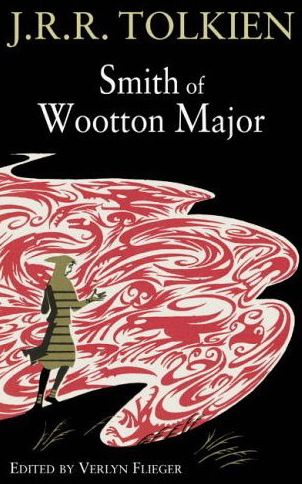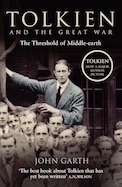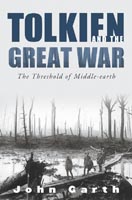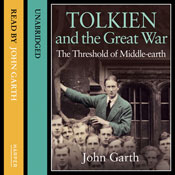John Garth
Smith of Wootton Major (expanded edition)
J.R.R. Tolkien. Edited by Verlyn Flieger. HarperCollins 2005
‘Do not read this! Not yet.’ It is characteristic of J.R.R. Tolkien that he should tell readers to skip his introduction to a George MacDonald fairy-tale and to read the story itself first, without a road map. But he might as well have said, ‘Read my story instead’ — for he quickly realised two things: he didn’t much like MacDonald’s moral allegory, and he would rather make his points about fairy-tales by creating one himself. He never finished the introduction he had been asked to write. Instead, we have Smith of Wootton Major: a counter-story to cure us of the notion that fairy-tales are only for children.
 Smith, once described as Tolkien’s ‘Prospero speech’, is the work of an old man, and deals with the surrender of one’s heyday powers. First published in 1967, when Tolkien was 75 and had more or less abandoned the idea of ever finishing his lifelong project, the mythological Silmarillion, the short tale came as a valedictory address to readers of The Hobbit and the cult epic The Lord of the Rings.
Smith, once described as Tolkien’s ‘Prospero speech’, is the work of an old man, and deals with the surrender of one’s heyday powers. First published in 1967, when Tolkien was 75 and had more or less abandoned the idea of ever finishing his lifelong project, the mythological Silmarillion, the short tale came as a valedictory address to readers of The Hobbit and the cult epic The Lord of the Rings.
Reappearing in an expanded edition, Smith of Wootton Major reads now as a challenge to the makers of today’s fantasy, who inevitably follow Tolkien even if they prefer to imagine (stand up, J.K. Rowling!) that they are not writing fantasy at all or do so only to ‘subvert’ it.
The story is pared down, minimalist. A small silver star is hidden in a gaudy festival cake. The boy who finds it, the eponymous Smith, grows up to wear it on his forehead as a passport to Faery, the land of wonder and terror mysteriously entwined with ours. Inscrutable glimpses of awe and beauty follow, most memorably a lake of glass and a birch tree in a ravening wind. Smith brings back things of wonder, and in his smithy forges things of unfamiliar beauty. Yet in the end he must relinquish the star so it can pass, via a new Great Cake, to another.
You might (as Tolkien would urge) read Smith of Wootton Major simply as a story. But that, it turns out, is not all that the author himself did. His private commentary, flowering into an extensive back-story, appears for the first time in this new edition (which also retains the original, haunting Pauline Baynes illustrations). Early drafts, starting with that abortive MacDonald introduction, are illuminating.
| “Perhaps Smith is Tolkien himself, venturing without a map far deeper into Faery than his predecessors – and creating a fantasy far more extraordinary” |
Strikingly, Smith’s star started out as a magic ring. It’s not that Tolkien was stuck for new ideas. He did not need them: he was re-examining a theme that had always been central to his art, including The Lord of the Rings, where the hero is so in love with
his magic token that when it comes to the crunch he will gamble the world rather than give it up. Other parallels with the more famous Ruling Ring would have been misleading, though, so the ring on the finger became a star on the brow — an even older sign of the mortal adventurer in Faery, dating back to Tolkien’s very earliest First World War writings.
What is new in Smith of Wootton Major is the terse mode and the mood of resignation, sad yet gracious. Travellers in the ‘perilous realm’ in Tolkien’s other works have always learned much, but what Smith learns most acutely is that enchantment must always elude the grasp of mind or hand. ‘Faery represents ... a love and respect for all things,’ as the commentary puts it, ‘an unpossessive love of them as “other”.’
Tolkien’s thoughts on his art are nowhere more pithily expressed. A detailed philosophy – yes, even a partial allegory – underlies the tale, a defence of the imagination in a world overtaken by commerce. Perhaps the cake represents the fairy-stories of George MacDonald and others that the young Tolkien read, and perhaps Smith is Tolkien himself, venturing without a map far deeper into Faery than his predecessors and creating a fantasy far more extraordinary.
The posthumous message, for today’s frantic writers of fantasy, may be this: forget subverting the tradition, which is just fiddling around with the cake ingredients. You must find your inspiration elsewhere. Exactly where is as elusive as Faery itself.
© John Garth.
I originally wrote this review for the London Evening Standard on publication of the book in 2005 but due to lack of space it did not reach print.
The Worlds of
J.R.R. Tolkien
UK hardback

US hardback

To buy in French, Russian, Czech, Spanish, Italian, Finnish, Hungarian, German, or another language
see links here
Buy
Tolkien and
the Great War
UK paperback/ebook

US paperback/ebook

Audiobook read by
John Garth

Amazon UK, Audible UK,
Audible US
To buy in Italian, German, French, Spanish or Polish,
see links here
Buy
Tolkien at
Exeter College
